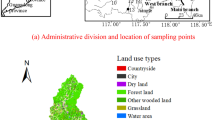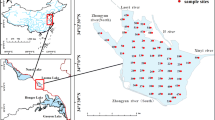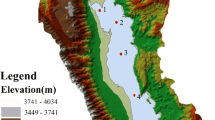Abstract
Nickel (Ni) in small plateau lake sediments plays an important role in influencing the quality of lake ecosystems with a high degree of endemism and toxicity. This paper focuses on the spatial distribution and ecological risks of nickel in the sediments of Jianhu Lake, a small plateau lake in China, and the influence of pH and total organic carbon (TOC) on nickel concentrations. The results showed that average total nickel concentrations were 138.99 ± 57.57 mg/kg (n = 38) and 184.31 ± 92.12 mg/kg (n = 60) in surface sediments (0–10 cm top layer) and sediment cores (0–75 cm depth), respectively, and that the residual fraction was the main form of nickel. Simultaneously, through a semivariogram model, strong spatial dependence among pH, TOC, and the oxidizable fraction was revealed, whereas total nickel, exchangeable and the weak acid soluble fraction, reducible fraction, and residual fraction showed moderate spatial dependence. The vertical distribution revealed that nickel accumulated mainly in the bottom 5 cm (70-75 cm) of the sediment layer and that the pH was higher there, whereas TOC was concentrated mainly in the top 5 cm of sediment. Using geoaccumulation and a potential ecological risk index, moderate nickel pollution and moderate risk levels were found in most surface sediments, but moderate nickel pollution and high risk levels were observed in most sediment cores. In addition, pH and TOC were found to have a strong effect on the distribution and concentration of nickel and its fractions in the small plateau lake. In summary, nickel posed a certain degree of pollution and ecological risk, which deserves attention in the sediments of small plateau lakes.








Similar content being viewed by others
Data availability
Most of the data generated or analyzed during this study are included in this published article. The other data sets generated and/or analyzed during the current study are not publicly available due to the restrictions of the local environmental management department but are available from the corresponding author on reasonable request.
References
Bachmann TM, Friese K, Zachann DW (2001) Redox and pH conditions in the water column and in the sediments of an acidic mining lake. J Geochem Explor 73(2):75–86
Bai J, Cui B, Chen B, Zhang K, Deng W, Gao H, Xiao R (2011) Spatial distribution and ecological risk assessment of heavy metals in surface sediments from a typical plateau lake wetland, China. Ecol Model 222(2):301–306
Bárcena JF, Claramunt I, García-Alba J, Pérez ML, García A (2017) A method to assess the evolution and recovery of heavy metal pollution in estuarine sediments: past history, present situation and future perspectives. Mar Pollut Bull 124(1):421–434
Bogunovic I, Mesic M, Zgorelec Z, Jurisic A, Bilandzija D (2014) Spatial variation of soil nutrients on sandy-loam soil. Soil Tillage Res 144:174–183
Bogunovic I, Kisic I, Mesic M, Percin A, Zgorelec Z, Bilandžija D, Jonjic A, Pereira P (2017) Reducing sampling intensity in order to investigate spatial variability of soil pH, organic matter and available phosphorus using co-kriging techniques. A case study of acid soils in Eastern Croatia. Arch Agron Soil Sci 63(13):1852–1863
Byrne P, Taylor KG, Hudson-Edwards KA, Barrett JES (2017) Speciation and potential long-term behaviour of chromium in urban sediment particulates. J Soils Sediments 17(11):2666–2676
Cambardella CA, Moorman TB, Novak JM, Parkin TB, Karlen DL, Turco RF, Konopka AE (1994) Field-scale variability of soil properties in central Iowa soils. Soil Sci Soc Am J 58(5):1501–1511
Chakraborty S, Man T, Paulette L, Deb S, Li B, Weindorf DC, Frazier M (2017) Rapid assessment of smelter/mining soil contamination via portable X-ray fluorescence spectrometry and indicator kriging. Geoderma 306:108–119
Chen SY, Lin JG (2001) Bioleaching of heavy metals from sediment: significance of pH. Chemosphere 44(5):1093–1102
Chen TR, Yu KF, Li S, Price GJ, Shi Q, Wei GJ (2010) Heavy metal pollution recorded in Porites corals from Daya Bay, northern South China Sea. Mar Environ Res 70(3-4):318–326
Chen CF, Chen CW, Ju YR, Kao CM, Dong CD (2018) Impact of disposal of dredged material on sediment quality in the Kaohsiung Ocean Dredged Material Disposal Site, Taiwan. Chemosphere 191:555–565
Cheng ZZ, Xie XJ, Pan HJ, Yang R, Shang YT (2011) Abundance of elements in stream sediment in South China. Earth Sci Front 18(5):289–295 (in Chinese)
CNEMC (China National Environmental Monitoring Center) (1990) Chinese soil element background value, vol 362-363. China Environmental Science Press, Beijing, pp 484–487 (in Chinese)
Dearing JA, Jones RT, Shen J, Yang X, Boyle JF, Foster GC, Crook DS, Elvin MJD (2008) Using multiple archives to understand past and present climate–human–environment interactions: the lake Erhai catchment, Yunnan Province. China J Paleolimnol 40(1):3–31
Duodu GO, Goonetilleke A, Ayoko GA (2016) Comparison of pollution indices for the assessment of heavy metal in Brisbane River sediment. Environ Pollut 219:1077–1091
Emmanuel E, Sombo T, Ugwanyi J (2018) Assessment of heavy metals concentration in shore sediments from the bank of River Benue, North-Central Nigeria. J Geosci Environ Prot 6:35–48
Gambrell RP (1994) Trace and toxic metals in wetlands-a review. J Environ Qual 23:883–891
Gringarten E, Deutsch CV (2001) Teacher’s aide variogram interpretation and modeling. Math Geol 33(4):507–534
Hakanson L (1980) An ecological risk index for aquatic pollution control-a sedimentological approach. Water Res 14(8):975–1001
Hu YL, Zheng W (2011) Research on sustainable development in plateau lake basins. Ecol Environ 236:168–183 (In Chinese)
Hu K, Chen G, Gregory-Eaves I, Huang L, Chen X, Liu Y, Leavitt PR (2019) Hydrological fluctuations modulate phototrophic responses to nutrient fertilization in a large and shallow lake of Southwest China. Aquat Sci 81:37. https://doi.org/10.1007/s00027-019-0633-4
Huang J, Yuan F, Zeng G, Li X, Gu Y, Shi L, Liu W, Shi Y (2017) Influence of pH on heavy metal speciation and removal from wastewater using micellar-enhanced ultrafiltration. Chemosphere 173:199–206
Idriss AA, Ahmad AK (2013) Heavy metals nickel and chromiumin sediments in the Juru River, Penang, Malaysia. J Environ Prot 4:1245–1250
Jain CK, Gupta H, Chakrapani GJ (2008) Enrichment and fractionation of heavy metals in bed sediments of River Narmada, India. Environ Monit Assess 141(1-3):35–47
Kalita S, Sarma HP, Devi A (2019) Sediment characterisation and spatial distribution of heavy metals in the sediment of a tropical freshwater wetland of Indo-Burmese province. Environ Pollut 250:969–980
Kerry R, Oliver MA (2007) Comparing sampling needs for variograms of soil properties computed by the method of moments and residual maximum likelihood. Geoderma 140(4):383–396
Klerk AD, Klerk LD, Chamier J, Wepener V (2012) Seasonal variations of water and sediment quality parameters in endorheic reed pans on the Mpumalanga Highveld. Water SA 38(5):663–672
Kuziemska B, Kalembasa S, Wieremiej W (2014) Distribution of nickel in fractions extracted with the BCR procedure from nickel-contaminated soil. J Elem 19(3):697–708
Laura M, Beatríz RM, Leobardo GO, Celia GF, Madelos AGO (1999) Toxic effect of nickel on hemoglobin concentration of Limnodrilus hoffmeisteri in spiked sediments of Trout Farms. Ecotoxicol Environ Saf 42(2):143–149
Li LH, Tang P, Yang TY, Tang X (2017) The soil geochemical background and the elements distribution characteristics in Dianchi Lake-Fuxian Lake area, Yunnan province. J Yunnan Univ 39(S2):357–370 (in Chinese)
Li Y, Zhou S, Zhu Q, Li B, Wang J, Wang C, Chen L, Wu S (2018) One-century sedimentary record of heavy metal pollution in western Taihu Lake, China. Environ Pollut 240:709–716
Lim WY, Aris AZ, Zakaria MP (2012) Spatial variability of metals in surface water and sediment in the Langat River and geochemical factors that influence their water-sediment interactions. Sci World J 2012:652150
Lin JG, Chen SY (1998) The relationship between adsorption of heavy metal and organic matter in river sediments. Environ Int 24(3):345–352
Ma R, Yang G, Duan H, Jiang J, Wang S, Feng X, Li A, Kong F, Xue B, Wu J, Li S (2011) China’s lakes at present: number, area and spatial distribution. Sci China Earth Sci 54(2):283–289
Mcgrath D, Zhang C (2003) Spatial distribution of soil organic carbon concentrations in grassland of Ireland. Appl Geochem 18(10):1629–1639
Myers N, Mittermeier RA, Mittermeier CG, Fonseca GABD, Kent J (2000) Biodiversity hotspots for conservation priorities. Nature 403(6772):853–858
Nazneen S, Singh S, Raju NJ (2019) Heavy metal fractionation in core sediments and potential biological risk assessment from Chilika lagoon, Odisha state, India. Quat Int 507:370–388
Olson DM, Dinerstein E (1998) The Global 200: a representation approach to conserving the Earth’s most biologically valuable ecoregions. Conserv Biol 12(3):502–515
Paul D (2017) Research on heavy metal pollution of river Ganga: a review. Ann Agrar Sci 15:278–286
Pueyo M, Mateu J, Rigol A, Vidal M, López-Sánchez JF, Rauret G (2008) Use of the modified BCR three-step sequential extraction procedure for the study of trace element dynamics in contaminated soils. Environ Pollut 152(2):330–341
Quan RC, Wen X, Yang X (2002) Effects of human activities on migratory waterbirds at Lashihai Lake, China. Biol Conserv 108(3):273–279
Rauret G, López-Sánchez JF, Sahuquillo A, Rubio R, Davidson C, Ure A, Quevauviller P (1999) Improvement of the BCR three step sequential extraction procedure prior to the certification of new sediment and soil reference materials. J Environ Monit 1(1):57–61
Soltan ME, Rashed MN, Taha GM (2001) Heavy metal levels and adsorption capacity of Nile River sediments. Int J Environ Anal Chem 80(3):167–186
Squires MM, Lesack LFW (2003) The relation between sediment nutrient content and macrophyte biomass and community structure along a water transparency gradient among lakes of the Mackenzie Delta. Can J Fish Aquat Sci 60(3):333–343
Trevisani S, Cavalli M, Marchi L (2012) Surface texture analysis of a high-resolution DTM: Interpreting an alpine basin. Geomorphol 161:26–39
Umoren IU, Udoh AP, Udousoro II (2007) Concentration and chemical speciation for the determination of Cu, Zn, Ni, Pb and Cd from refuse dump soils using the optimized BCR sequential extraction procedure. Environmentalist 27(2):241–252
Ure AM, Quevauvillier P, Muntau H, Griepink B (1993) Speciation of heavy metals in soils and sediments. An account of the improvement and harmonization of extraction techniques undertaken under the auspices of the BCR of the commission of the European Communities. Int J Environ Anal Chem 51:135–151
Viswanathan R, Jagan J, Samui P, Porchelvan P (2015) Spatial variability of rock depth using Simple Kriging, Ordinary Kriging, RVM and MPMR. Geotech Geol Eng 33(1):69–78
Wang M, Hu K, Zhang D, Lai J (2017) Speciation and spatial distribution of heavy metals (Cu and Zn) in wetland soils of Poyang Lake (China) in wet seasons. Wetlands 11:1–10
Wiese SBO, Macleod CL, Lester JN (1997) A recent history of metal accumulation in the sediments of the Thames Estuary, United Kingdom. Estuaries 20(3):483–493
Xiao H, Zang S, Guan Y, Liu S, Gao Y, Sun Q, Xu H, Li M, Wang J, Pei X (2014) Assessment of potential risks associated with heavy metal contamination in sediment in Aobaopao Lake, China, determined from sediment cores. Ecotoxicology 23(4):527–537
Xu ZQ, Ni SJ, Tuo XG, Zhang CJ (2008) Calculation of heavy metals, toxicity coefficient in the evaluation of potential ecological risk index. Environ Sci Technol 31(2):112–115 (in Chinese)
Xu YF, Wu Y, Han JG, Li PP (2017) The current status of heavy metal in lake sediments from China: pollution and ecological risk assessment. Ecol Evol 7(14):5454–5466
Ye S, Lin M, Li L, Liu J, Song L, Li Z (2015) Abundance and spatial variability of invasive fishes related to environmental factors in a eutrophic Yunnan Plateau lake, Lake Dianchi, southwestern China. Enviro Biol Fishes 98(1):209–224
Yi Y, Yang Z, Zhang S (2011) Ecological risk assessment of heavy metals in sediment and human health risk assessment of heavy metals in fishes in the middle and lower reaches of the Yangtze River basin. Environ Pollut 159(10):2575–2585
Yusuf M, Fariduddin Q, Hayat S, Ahmad A (2011) Nickel: an overview of uptake, essentiality and toxicity in plants. Bull Environ Contam Toxicol 86(1):1–17
Zahra A, Hashmi MZ, Malik RN, Ahmed Z (2014) Enrichment and geo-accumulation of heavy metals and risk assessment of sediments of the Kurang Nallah-Feeding tributary of the Rawal Lake Reservoir, Pakistan. Sci Total Environ 470:925–933
Zang F, Wang S, Nan Z, Ma J, Wang Y, Chen Y, Zhang Q, Li Y (2017) Influence of pH on the release and chemical fractionation of heavy metals in sediment from a suburban drainage stream in an arid mine-based oasis. J Soils Sediments 17(10):2524–2536
Zhang J, Li X, Yang R, Liu Q, Zhao L, Dou B (2017) An extended kriging method to interpolate near-surface soil moisture data measured by wireless sensor networks. Sensors 17(6):1–19
Zhao C, Liu S, Dong S, Isange S, Liu Q, An N, Li X (2015) Spatial and seasonal dynamics of organic carbon in physically fractioned sediments associated with dam construction in the middle Lancang-Mekong River. J Soils Sediments 15(11):2323–2333
Acknowledgments
We thank International Science Editing (http://www.internationalscienceediting. com) for editing this manuscript.
Funding
This study was supported by the National Natural Science Foundation of China (Grant No. 41877346).
Author information
Authors and Affiliations
Contributions
All authors contributed to the study conception and design. Material preparation, data collection, and analysis were performed by Bo Li, Hang Wang, Qingguo Yu, Feng Wei, and Qi Zhang. The first draft of the manuscript was written by Bo Li and all authors commented on previous versions of the manuscript. All authors read and approved the final manuscript.
Corresponding author
Ethics declarations
Competing interests
The authors declare that they have no competing interests.
Ethical approval
Not applicable.
Consent to participate
Not applicable.
Consent to publish
Not applicable.
Additional information
Responsible Editor: Philippe Garrigues
Publisher’s note
Springer Nature remains neutral with regard to jurisdictional claims in published maps and institutional affiliations.
Rights and permissions
About this article
Cite this article
Li, B., Wang, H., Yu, Q. et al. Spatial distribution and ecological assessment of nickel in sediments of a typical small plateau lake from Yunnan Province, China. Environ Sci Pollut Res 28, 14469–14481 (2021). https://doi.org/10.1007/s11356-020-11526-0
Received:
Accepted:
Published:
Issue Date:
DOI: https://doi.org/10.1007/s11356-020-11526-0




